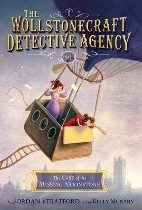 Jordan Stratford •
Jordan Stratford •
The Case of the Missing Moonstone •
It’s said that well-behaved women rarely make history. Jordan Stratford has taken that axiom a step further by conjuring up unconventional childhoods for Augusta Ada Byron and Mary Wollstonecraft Godwin, two noted renegades of the early 19th century.
Admittedly, Stratford has to indulge in some literary sleight of hand to make his characters roughly the same age and shoehorn them into London at the same time. But it’s easy to forgive that liberty when we see the use he makes of the device.
Ada and Mary become acquainted after a gunpowder experiment—“Oomph times zoom equals kaboom!”—fizzles out. Reclusive Ada, a computer programmer in embryo, excels at mathematics and logic, while spirited Mary (future author of Frankenstein) talks like Dr. Johnson’s dictionary and enjoys a vividly macabre imagination. Recognizing each other’s talents, the pair form the Wollstonecraft Detective Agency, “a private and secret constabulary for the apprehension of clever criminals.”
Book titles, plots, and character names throughout the series pay homage to a variety of period novelists, while playful dialog and cameos of famous figures make for lively reading. “There’s no one for you to tute,” Ada informs would-be tutor Peebs (short for Percy Bysshe Shelley). “Who the dickens was that boy?” muses Peebs after encountering young Charles, who works in a boot-polish factory, reads incessantly, and pretends to be invisible. When Ada expresses a desire to put criminals in the newspaper, Mary counters, “Criminals go to prison, not to the newspaper.”
The two girls’ strengths dovetail neatly as they are shut in Newgate Prison, give chase by hot-air balloon, and thwart a jewel theft. Subsequent books find them hunting dinosaur bones, breaking codes, and recovering the secret diary of a nine-year-old royal named Victoria.
Just wait til they grow up.






Your email address will not be published.